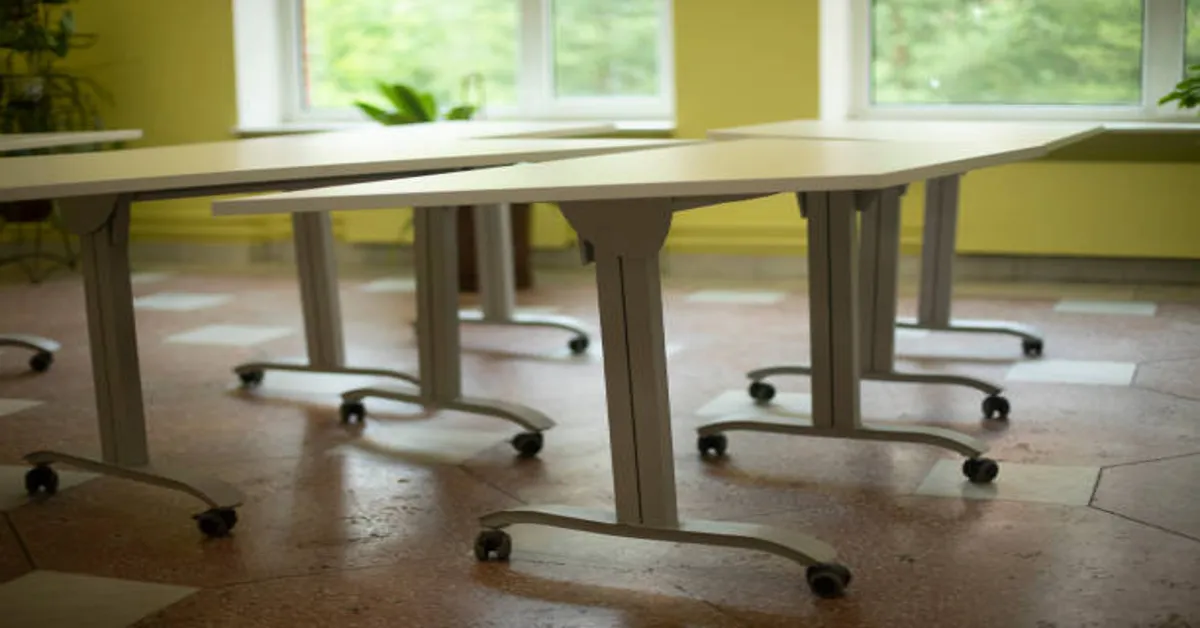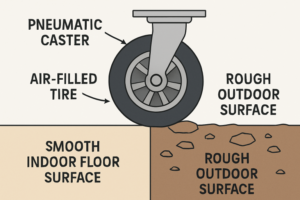A folding table is one of the most versatile pieces of furniture you can own. Whether you live in a small apartment, manage a large event venue, run a school, or simply love camping in the great outdoors, folding tables can be a true game-changer. Their design makes them practical for quick setup and storage, while their range of materials and sizes ensures that there’s a suitable option for almost every need. Many people see folding tables simply as “extra tables” for occasional use, but the reality is that they serve far more purposes and can even be central to daily living.
In this complete guide, we will take a deep dive into what folding tables are, how they are built, their advantages and disadvantages, the different types available, where they are commonly used, and how to take care of them so they last for years.
Understanding the Folding Table Concept
A folding table is designed with a unique mechanism that allows it to collapse into a smaller, more compact form. This design typically involves hinges, folding legs, or a folding tabletop. The main idea behind a folding table is space efficiency — the ability to store it away easily when it is not in use. Unlike fixed tables, which take up permanent space, folding tables can be brought out only when needed, making them ideal for dynamic spaces where flexibility matters.
Although the modern folding table often uses lightweight materials like aluminum and plastic, the concept is not new. In fact, ancient civilizations used collapsible furniture for travel and military campaigns. Over the centuries, materials and designs have evolved, but the goal has remained the same: create a functional surface that is easy to move and store.
Why Folding Tables Are So Popular
There are several reasons folding tables have become a staple in homes, schools, offices, restaurants, and outdoor venues. Here are the most notable:
1. Space Saving
The most obvious benefit is their ability to save space. When folded, a table can be tucked into a closet, behind a door, or under a bed. This is especially important in small apartments or multipurpose rooms.
2. Portability
Folding tables are generally lightweight and often have carrying handles, making them easy to transport. This portability is a big plus for events, catering, and outdoor activities.
3. Flexibility
Because they are not fixed in place, folding tables can be used in different rooms and for different purposes, from temporary workspaces to buffet stations at a party.
4. Cost-Effective
Many tables are more affordable than permanent, heavy furniture, offering excellent value for money.
5. Easy Maintenance
Most tables are made of materials that resist stains, scratches, and weather damage, making them easy to clean and maintain.
Key Components of a Folding Table
Understanding how folding tables are built will help you choose one that suits your needs. The main components include:
1. Tabletop
The tabletop can be made of wood, laminated particleboard, metal, or molded plastic. Each material has its advantages. For instance, plastic tabletops are lightweight and weather-resistant, while wooden tops offer a more classic and elegant appearance.
2. Hinges or Folding Mechanisms
The folding mechanism is the heart of the table’s design. It allows the legs to collapse and sometimes even the tabletop to fold in half. The quality of hinges is important because it determines stability and longevity.
3. Legs
Folding table legs are often made of tubular steel or aluminum for strength and reduced weight. Some legs have locking systems to prevent accidental collapse during use.
4. Feet or Base Caps
To protect floors and improve grip, most tables have rubber or plastic caps at the ends of their legs.
Different Types of Folding Tables
Folding tables come in various designs, each catering to specific uses. Here are the most common types:
1. Banquet Folding Tables
These are large, rectangular or round tables often used at events, weddings, and conferences. They are sturdy, can seat many people, and are easy to transport in bulk.
2. Card Tables
Smaller and usually square, card tables are designed for games, puzzles, and small gatherings. They are lightweight and easy to store.
3. Camping Folding Tables
Specifically designed for outdoor use, these are compact, weather-resistant, and sometimes have adjustable heights for cooking or dining.
4. Wall-Mounted Folding Tables
These are attached to a wall and fold down when needed. They are ideal for small kitchens, laundry rooms, or garages where floor space is limited.
5. Adjustable-Height Folding Tables
These tables can be set at different heights, making them versatile for different activities such as dining, crafting, or working while standing.
6. Folding Picnic Tables with Benches
Often used in parks or backyards, these combine seating and table space in one foldable unit.
Materials Used in Tables
The material of a table affects its durability, weight, appearance, and cost.
Plastic
High-density polyethylene (HDPE) is a popular choice because it is lightweight, stain-resistant, and suitable for outdoor use.
Wood
Solid wood or wood veneer offers a warm, natural look but may be heavier and require more care.
Metal
All-metal tables are extremely durable but can be heavy; they are often used for industrial or workshop purposes.
Composite Materials
These combine plastic, wood fibers, and resins to balance durability and weight.
Choosing the Right Folding Table
When selecting a folding table, consider these factors:
- Purpose: Will it be for dining, working, crafting, or outdoor activities?
- Size: Ensure it fits your space when in use and storage.
- Weight Capacity: Some tables can hold heavy loads, while others are for light use.
- Portability Features: Handles, locking systems, and wheel attachments can improve convenience.
- Aesthetics: Choose a style and color that complements your environment.
Common Uses for Folding Tables
The versatility of tables means they appear in many environments:
At Home
Used as extra dining space during gatherings, as a homework station, or for hobbies like sewing and painting.
In Offices
Used for temporary workstations, training sessions, and conference setups.
In Schools
For science fairs, art exhibitions, and exams.
In Events and Hospitality
For buffets, vendor booths, and banquet seating.
Outdoors
For picnics, camping, barbecues, and flea markets.
Maintenance and Care
Proper care will extend the lifespan of a table:
- Cleaning: Wipe with a damp cloth and mild soap; avoid harsh chemicals unless the material is chemical-resistant.
- Storage: Keep in a dry area to prevent rust or warping.
- Check Hinges and Locks: Ensure mechanisms are working properly before use.
- Avoid Overloading: Respect the weight limits to prevent damage.
Advantages and Disadvantages
Advantages:
- Space-saving design
- Portability
- Affordable
- Easy to maintain
- Versatile usage
Disadvantages:
- May not be as stylish as permanent furniture
- Lightweight models can be less stable
- Hinges and moving parts may wear over time
Sustainability and Eco-Friendly Options
With growing awareness of environmental issues, manufacturers now offer tables made from recycled plastics or sustainably sourced wood. Some designs are modular, allowing parts to be replaced instead of discarding the entire table. This approach reduces waste and supports a greener lifestyle.
Safety Considerations
While folding tables are generally safe, it’s important to:
- Lock legs securely before use.
- Keep fingers clear of hinges during folding/unfolding.
- Avoid leaning heavily on one side, especially with lightweight models.
- Supervise children when folding or unfolding the table.
Innovations in Folding Table Design
Modern tables often include features like:
- Built-in storage compartments
- Weatherproof coatings
- Height adjustability
- Integrated seating
- Fold-in-half designs for compact storage
Conclusion
A folding table is far more than just an occasional piece of furniture — it is a flexible, space-saving, and functional solution for countless situations. Whether you need a quick dining area for guests, a portable work desk, or a reliable table for outdoor activities, there is a table suited for the task. By understanding the different types, materials, and care techniques, you can select a table that will serve you well for many years.
ALSO READ: Media Wall: The Complete Guide to Design, Technology, Benefits, and Installation
FAQs
1. What is the weight limit of a folding table?
Weight limits vary depending on size, material, and construction. Light-duty tables may hold around 50 kg, while heavy-duty banquet tables can support over 200 kg.
2. Can folding tables be used outdoors?
Yes, especially those made of plastic or treated metal. However, prolonged exposure to extreme weather can reduce their lifespan.
3. How do I clean a folding table?
Use mild soap and water for most surfaces. Avoid abrasive cleaners that could scratch plastic or remove wood finishes.
4. Are folding tables safe for children?
Yes, but ensure legs are locked and supervise folding/unfolding to prevent pinched fingers.
5. How long do folding tables last?
With proper care, a quality folding table can last many years, even with regular use.









